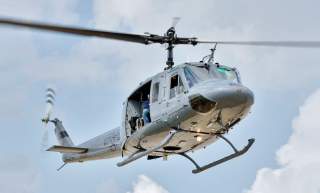Meet the Xm-215 Gun: It Fires 1000 Rounds in 10 Seconds
But it wasn't used.
Key Point: Such a weapon was impressive but useless on the battlefield.
While a fixture on the modern battlefield, helicopters are especially vulnerable when hovering low to the ground and dropping off troops. For almost 60 years, the U.S. Army and other services have tried out different weapons to protect choppers as they land and take back off again.
Some of these ideas proved better than others. In November 1968, the Army’s Limited War Laboratory began work on a huge shotgun mounted on the front of helicopters, where it blasted out a wall of tiny bullets at anyone unlucky enough to be on the ground.
It didn’t work out. For one, American commanders in Vietnam—where the Viet Cong routinely ambushed helicopters as they descended—weren’t interested in a weapon that might kill as many friendly troops as enemy ones.
“This system will provide troop-carrying helicopters with an immediate, close-in … fire capability during landing and take-off in combat,” stated the Limited Warfare Lab’s progress reports.
At its core, the weapon had four clusters of .22-caliber barrels, each pre-loaded with a single cartridge. Every one of these XM-215 “Multiple Barrel Guns” had more than 300 separate barrels.
At the touch of a button, a crew member could fire more than a thousand rounds in 10 seconds in a 40-degree arc in front of the helicopter.
The whole system resembled a honeycomb. But this scattergun could also shoot its fearsome barrage at a slower pace, for up to 40 seconds of continuous fire.
This so-called “Suppressive Fire Weapon System for Helicopters” was the product of years of experience—and competing viewpoints. At the time, helicopters were still relatively new kinds of aircraft.
Five years before the project began, the Army was debating what the military helicopter’s proper role should be. Obviously, an attack helicopter should carry weapons. But should a transport carry any? If so, how many?
After months of shuttling South Vietnamese troops around, most Army officials felt that only dedicated armed gunships should get any weapons. Of 11 military advisers to Saigon polled in 1964, only four wanted guns on transports.
The officers believed weapons would weigh down the vulnerable transport helos, making them easier prey than they already were, and further limiting the number of troops they could carry.
Army evaluators came to the same conclusions as they tried strapping different combinations of guns and rockets onto their rapidly expanding chopper fleet. The service quickly abandoned plans to put four machine guns on the front of the rotary-wing transports.
Pilots said the mounts were too heavy and threw off their helicopters’ balance. If the weapons fired from further back on the fuselage, troops would likely stray in front of them as they hopped out.
But it wasn’t like the alternative was much better.
The Viet Cong were adept at ambushing defenseless helicopters as they landed, often out of reach of the escorting gunships. American gunners were sometimes afraid to shoot if the guerrillas got too close to friendly soldiers.
Besides the ambushes, insurgents filled landing zones with deadly traps. American helicopters needed ample room to touch down—and clearances stuck out like sore thumbs in the dense jungles.
“Possible helicopter landing areas often are filled with bamboo stakes … sharpened at both ends,” according to one contemporary report. “In some cases, stakes have been wired together and mined or booby-trapped.”
The Army responded by putting M-60 machine guns on both sides of the UH-1 Huey and CH-47 Chinook helicopters. The Chinooks also got a third gun on their rear cargo ramp.
But gunships were still supposed to be the primary means of beating enemy forces back from landing zones. The slow-firing M-60s could only cover so much ground on their own.
Enter the Limited War Lab’s light-weight, front-mounted shotgun. In theory, it offered a potential solution to the transport helicopters’ weight and safety problems. With the barrage weapon loaded up, chopper crews could pin down insurgents, drop off their troops and cargo, and then get back into the air before taking damage.
But the new system offered a new set of problems. The downwash from the aircraft’s rotors risked interfering with the aerodynamics of the small, .22-caliber bullets as they flew out of their barrels.
And while troops on board might not have been running past the barrels, the wide field of fire was still dangerous to friendlies in a tightly-packed landing zone.
Perhaps most damning, the shotgun was a single-shot weapon—or rather, a weapon that fired a lot of bullets all at once. After that, the weapon system was just dead weight. Defeating its primary purpose, it couldn’t deliver effective suppressive fire.
In May 1971, the Army canceled the project. By that point, lab technicians at the Aberdeen Proving Ground made four of the unique guns.
“The anticipated request for RVN evaluation did not materialize,” is all the progress updates have to say on the matter. RVN in this case refers to the Republic of Vietnam, the official name of South Vietnam.
The technicians insisted the weapons were available, if anyone was interested. We don’t know what eventually happened to the prototypes.
But to this very day, Army transport helicopters still rely heavily on the same kind of side-mounted machine guns that protected their predecessors in Vietnam. With more staying power—and fewer barrels—than the giant shotgun.
This piece was first featured in 2018 and is being republished due to reader's interest.
Media: Wikimedia.

